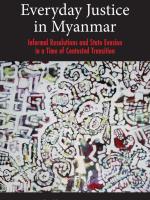Why is Customary Law so strong?
Introduction The Naga Self-Administered Zone (SAZ) is located in the north-western corner of Myanmar on the border with India. Since 2003, Naga leaders from the different sub-tribes have worked together to codify a common customary law for all the linguistically different Naga sub-groups. A core aim is to unite the various Naga groups around a common identity and to obtain Myanmar state recognition of Naga customary law. Engaging the debate on legal pluralism, this chapter provides nuanced and ethnographically-based reflections on the pros and cons of state recognition of customary law. It does this by exploring the strengths of the Naga customary justice system in one rural and one urban context within Layshi Township in the Naga Self-Administered Zone (SAZ). The fieldwork underpinning the findings and analysis presented in the chapter was conducted from mid-2017 to early 2019.
The current political transition in Myanmar has allowed for bigger efforts to institutionalise Naga customary law and legal practices, but the process had already begun in the 1990s, when the Naga leaders organised the Naga Literature and Culture Committee Central (NLCC-C) to improve access to justice for all the different Naga tribes and to create a shared Naga spoken and written language. The NLCC-C is now working to achieve Myanmar state recognition of a codified version of Naga customary law (NLCC-C 2003). We argue that the strengthening of customary law is part of a Naga nation-building effort that seeks to unite the Naga sub-groups around a shared group identity and to protect this identity against erosion by the majority Bamar culture and by the political influence of state-led nation building.
While key aspects of the history of the Naga, including in particular questions related to political and cultural identity, are dealt with in existing literature (Hutton, 1965 and 1969 [1922]; Kotwal 2000; Stirn and van Ham 2003; Tohring 2010; Thomas 2016), not much has been written on justice and the ways in which it is dispensed within Naga society. Based on data from in-depth interviews with rural and urban residents and leaders, women as well as men, in the Naga SAZ, this chapter provides novel insights into an area that has so far been overlooked in the scholarship on Myanmar and legal pluralism.2 The fieldwork underpinning our analysis was conducted in Layshi Township, focusing on two sites: the main rural village of the Naga Goga tribe, which we here call Dah Tri Gyu village, and a ward in Layshi town.3 Focusing on these two sites allowed us to explore possible differences in dispute resolution across the rural–urban divide. We do, however, remain aware that our analysis is limited in both time and space and does not enable us to generalise across all Naga sub-groups.
To situate our findings within the wider literature, the chapter begins with a brief discussion of legal pluralism, followed by a shorter overview of the Naga and the main characteristics of their social organisation. Following that, we describe the Naga justice system, including Naga principles of justice and procedures and the Naga Book of Customary Law (NLCC-C 2003), and we discuss the ways in which these have been applied in practice in three specific cases of dispute resolution. In the conclusion we return to the overall question of state recognition of customary law within the current Myanmar transition, in order to discuss the various dilemmas it presents both for the Naga and for the Myanmar state and international donors.
To read the full chapter - click on the PDF link.
Watch webinar about the book
9 October 2020, the London School of Economics hosted a webinar on Everyday Justice in Myanmar.
Watch the webinar here.
DIIS Experts



